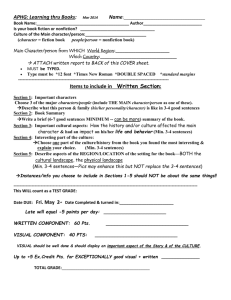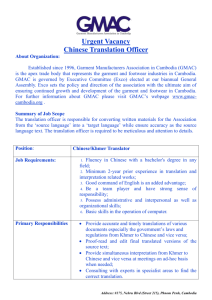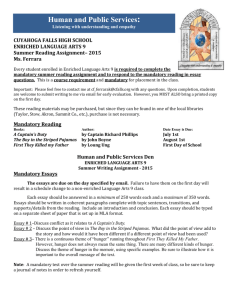5723675_YAL-Critique
advertisement
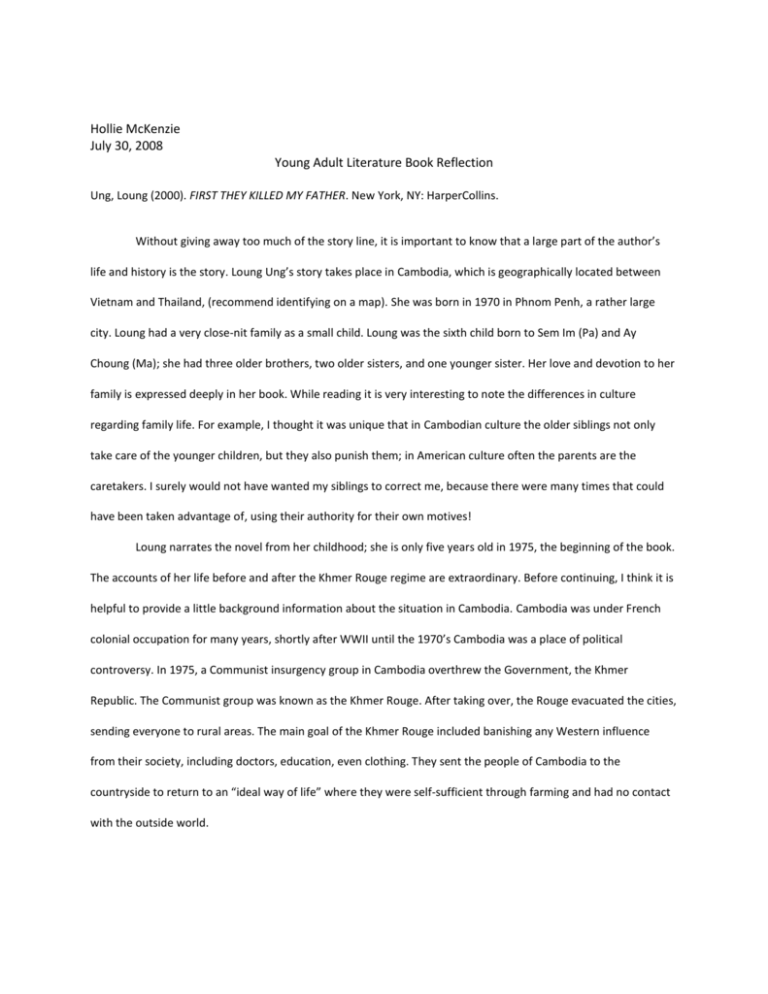
Hollie McKenzie July 30, 2008 Young Adult Literature Book Reflection Ung, Loung (2000). FIRST THEY KILLED MY FATHER. New York, NY: HarperCollins. Without giving away too much of the story line, it is important to know that a large part of the author’s life and history is the story. Loung Ung’s story takes place in Cambodia, which is geographically located between Vietnam and Thailand, (recommend identifying on a map). She was born in 1970 in Phnom Penh, a rather large city. Loung had a very close-nit family as a small child. Loung was the sixth child born to Sem Im (Pa) and Ay Choung (Ma); she had three older brothers, two older sisters, and one younger sister. Her love and devotion to her family is expressed deeply in her book. While reading it is very interesting to note the differences in culture regarding family life. For example, I thought it was unique that in Cambodian culture the older siblings not only take care of the younger children, but they also punish them; in American culture often the parents are the caretakers. I surely would not have wanted my siblings to correct me, because there were many times that could have been taken advantage of, using their authority for their own motives! Loung narrates the novel from her childhood; she is only five years old in 1975, the beginning of the book. The accounts of her life before and after the Khmer Rouge regime are extraordinary. Before continuing, I think it is helpful to provide a little background information about the situation in Cambodia. Cambodia was under French colonial occupation for many years, shortly after WWII until the 1970’s Cambodia was a place of political controversy. In 1975, a Communist insurgency group in Cambodia overthrew the Government, the Khmer Republic. The Communist group was known as the Khmer Rouge. After taking over, the Rouge evacuated the cities, sending everyone to rural areas. The main goal of the Khmer Rouge included banishing any Western influence from their society, including doctors, education, even clothing. They sent the people of Cambodia to the countryside to return to an “ideal way of life” where they were self-sufficient through farming and had no contact with the outside world. During the evacuation of cities, many Cambodian civilians died. Many were killed from being associated with the old government, or for being “corrupt”; many innocent people were viewed as corrupt if they were knowledgeable or if they were middle or upper class, this included doctors, officials, teachers, people living in cities were viewed as corrupt and below the agrarian citizens. Once they reached the countryside, conditions were horrible. Limited housing available, not enough food and they constantly lived in fear of the Khmer Rouge. Loung and her family experienced the evacuation of their home; they traveled in fear for many weeks with no dependable food source and were starving to death. Once they reached their destination, a rural village, they were forced to work long hours in the sultry climate. They were beaten, had their possessions taken from them, and were forced to live in a small hut, only given small rations of food each day by the Khmer Rouge. The Ung family moved several times, in fear that Pa’s connection with the old government would be found out and they would all be killed. Finally, after several moves, the family was slowly torn apart. Older siblings were sent to work camps for people their age. Some members of the family were ill and taken to infirmaries; make shift hospitals with erroneous doctors and nurses. Unfortunately, Loung lost family members from murder and illness. She was eventually separated entirely from her family, and faced challenges alone (keep in mind, Loung was only a child). After several years of Khmer Rouge rule, Cambodia was slowly liberated when Vietnamese troops invaded the country and attacked the Khmer Rouge. During this time, Loung reunited with the surviving members of her family, and was able to escape Cambodia with her eldest brother. For several months Loung and Meng waited in Thailand, as refugees, for a sponsor in America. Once they found a sponsor in America, Loung and Meng traveled to Vermont, to become United States citizens. In her book, Loung speaks briefly of her time in America as an adolescent. She became interested in American culture. Loung learned English, played sports, joined the cheerleading squad, graduated from high school, and then college. She was very successful in America, yet her past haunted her. She references her feelings and memories of Cambodia when she would view similar situations on the news, like the Ethiopian crisis. After fifteen years in America, Loung returned to Cambodia to reunite with her family and attend a memorial service for those who died. It is estimated, that during the Khmer Rouge regime, two million Cambodians died; this is a huge number, especially given the total population was only seven million. Even at a young age, Loung’s life was forever affected by this tragic event. Today, Loung has written two books regarding her experience in Cambodia. She is a National Spokesperson for the Campaign for a Landmine-Free World and on the Advisory Board for Hewlett-Packard’s World E-Inclusion Initiative and the Cambodian Association of Chicago, IL. Loung has also been selected by the World Economic Forum as one of the “100 Global Youth Leaders of Tomorrow.” Loung has persevered through her tragic childhood. Not only has she taken the negative and made a positive life from it, but she also has utilized her experience to educating others about the event, in hopes that through education, such an event will not happen again. To present the book more in-depth, I will begin by developing the setting. As stated earlier, it is very important to locate Cambodia on a map, in order to visualize the location of the country and understand the location of the cities, this is especially helpful to reference when reading the book, as the family relocates several times. Ung does a wonderful job in describing the setting. The book begins in Phnom Penh, a larger city in Cambodia. Phnom Penh is described as bustling, with people up early; working an earlier shift to avoid the heat that settles after morning. Once the temperatures rise, Cambodians continue to work; stopping for a midday break around 2pm. During this break, many went home to have lunch, take showers, and nap; then they would return to their jobs. Loung describes the restaurants where Cambodians would enjoy noodles for breakfast. In great detail, Loung recalls her family eating breakfast together every day. In comparison to American culture, it is rare for a family to go out to eat every day for breakfast, even with the lack of appliances, such as a refrigerator, women often would prepare meals in the home. I found this cultural comparison and many others to be very interesting. During her childhood, the streets of Phnom Penh were lined with vendors selling carts of scrumptious foods. Loung describes her childhood playing in these streets with children from the neighborhood, she describes the joy of riding in a cyclo (a large wheelchair attached to a bike, a driver pedals the bike, and the passengers ride in the chair) daily with her mother as they went to the market for groceries. In Phnom Penh, Loung’s family lived in a beautiful apartment. She describes them as a middle-class family; they had plenty of room, food, and clothes. They even had a nanny to help care for the children and perform household duties. Loung talks about her experiences in Phnom Penh as a young child, I particularly like when she references the candy dish at her house. Her mother kept good candies for occasions when guests were visiting, often Loung would press her face to the glass pane of the cabinet, sometimes her mother would pity her and give her a piece, other times her mother would swat her away. This story I liked because I think many people, despite cultural differences, can relate to a similar experience as a child. After her family was evacuated from Phnom Penh they relocated in Krang Truop, Loung describes as a “small and dusty village surrounded by rice fields.” In this village they resided briefly with family. This was a culture shock even to Loung at the age of five. She was accustomed to the city she lived in, the spacious apartment, and the food available on every street corner. In Krang Truop, Loung found herself sharing a hut with seventeen other people. The hut was constructed of straw walls and a straw roof, and had a dirt floor; there were no bathrooms or bedrooms, only one large open space. At her young age, Loung was already familiar with the concepts of privacy and individual property, in her new world, neither of these was an option. It would be difficult for any age to adjust to such a radical change of life, and I am sure Loung’s parents and siblings experienced similar thoughts and fears; yet, Loung expresses her trouble with grasping these changes in great detail and I think it is important to consider such a young impression of the event. Often times in history, accounts of events are from adults, it is rare to listen to the thoughts of a five year old, but equally important to comprehension, and sometimes a new idea will be brought forth that otherwise may have not been. As Loung’s story continues, and her situation, as well as other Cambodians begins to fall apart, she and her family are relocated several times and eventually split apart. With each move, Loung intricately describes the setting around her. There is much sorrow and fear in Cambodia. The smell and site of death becomes a common occurrence. Families disappear overnight, never to be heard from again. Each day Loung and her family join other families working in the gardens, trying to produce massive crops, as ordered by the Khmer Rouge. The scene of waiting for food rations is delicately described by Loung, as food was her major concern and thought for many years during the Khmer Rouge regime. The camps for young working children are discussed by Loung. The setting, a rural area with a few small insignificant buildings, where eighty girls her aged are housed. During this time, she is completely alone and the youngest at the camp. She describes the attitudes of the other girls and the camp leaders, the confusion she experiences as she sits through daily lessons, more or less brainwashing children to the almighty powers of the regime. I enjoyed the descriptive setting provided while reading, not only was I able to get a physical picture of her surroundings, but I could also depict her emotional setting which was painful, yet without the emotional setting a part of her story would be lost. For example, when Loung returns to her mother’s village only to learn that the day before her mother and youngest sibling were “taken” by Khmer Rouge soldiers, she describes her state of unconsciousness. For three days she cannot account for her own whereabouts. It seems strange perhaps, but what I found interesting about this section was, even though the book gives no physical setting or explanation, none can be provided, I could understand Loung’s emotional setting. Although I have not felt such pain, I can imagine this time Loung was in a place of shock, her body and mind could not handle anymore and she experienced a disconnect to prevent the pain and truth from seeping into her reality. My heart goes out to Loung and her experiences, and I am thankful she can describe them, even when she cannot. Loung does a beautiful job of describing her family and their relationship, individually to the reader. It is clear from the beginning and confirmed throughout the book, her Pa is her favorite, and in return she is his. Loung describes herself as a mischievous child, always curious and asking questions, she was headstrong and somewhat opinionated. In comparison to her siblings, Loung was a firecracker; the infamous middle child, even though she wasn’t exactly. In their culture, Cambodian girls and women are found to be beautiful in part by their manners. A woman was appreciated for her quietness, reserved demeanor, never to raise her voice, while remaining aesthetically pleasing. Loung was often told by her mother of her inappropriate behavior and told to act more like a lady, but her Pa called her “a diamond in the rough”, for he appreciated her thoughts and questions. Physically, Loung was a beautiful child. In Cambodian culture it is not appropriate to complement a child because it is believed evil spirits will be jealous of the child and take them to another world. So, as a child, Loung was often told she was “ugly” for her shiny hair and smooth skin. I thought this was an interesting comparison of culture. Loung’s father, Sem Im, was a wonderful father and husband. He provided for his family and was caring and kind towards them. Before the Khmer Rouge regime, he was an officer for the Lon Nol government. After the takeover, Pa tried and succeeded in protecting his family from being identified as traitors. He worked very hard at each village, and tried to supplement the low food rations by gardening and selling hidden possessions. As a reader, I developed an emotional attachment to the relationship between Loung and Pa. They understood and appreciated each other, in ways other family members did not. Loung’s mother, Ay Choung is described as a beautiful and proper lady. Her relationship with Loung was different from Sem Im. Ma wanted to change Loung’s attitude and disposition she encouraged her to be more obedient and lady like. At times I felt a tension between Loung and Ma; Loung longed for her mother to accept her and cherish her as the unique child she was. There is a part in the story where Ma forces the remaining children to leave the hut, venture out into the countryside in different directions and claim to be orphans, in hopes of keeping their identities unknown and saving their lives. Loung was hesitant to leave her mother, but her mother swatted her on her bottom and told her to leave. No hugs, no kisses, no tears. I understand the reasoning behind her mother’s motives, but not the lack of emotion. Later, by chance, the family was briefly reunited, during this time, it seemed Ma took special interest in the care of Loung, combing her hair is a specific example. I felt maybe the mother might have been compensating for previous actions, but by this time Loung felt a surge of independence and was not responsive to her mother’s attention as she might have been earlier. The next encounter in the book is when Loung discovers her mother has been taken by soldiers. I would be lying if I said I did not cry at this point, it wasn’t the fact that Ma was dead, but rather the lost connection between a mother and a daughter. Loung also develops her siblings and their relationship. Her eldest brother, Meng was quite, meek, and kind. He stayed with the family for a while after the evacuation and then was sent to a camp for young men. Even then he saved food to bring to the family whenever he got a chance. Meng is probably closer to Loung then her other brothers, for he is the one who chose Loung to go with him to America. Chou is Loung’s sister, only two years older than Loung, but with a very different personality. Loung often talks about how meek and reserved Chou is. Even when Loung acts like a typical younger sibling, Chou is often quick to forgive and never retaliates. Sometimes I felt like some of Loung’s strength was from Chou’s weakness. Loung mentions the two are very close today and visit each other often. The three other siblings were briefly discussed in the book; an older brother, second eldest, I mentioned before. He was very aggressive and often corrected the younger children. Loung had one older sister, a typical teenager obsessed with clothes and boys, who often yelled at Loung for sneaking into her room and wearing her clothes. And finally, Geak, the youngest, only an infant at the time of takeover. Loung expressed deep concern and sorrow for Geak, who was always crying for food, but since she was so young Loung lacked verbal communication with her. I would regard this book as an excellent read for young adolescents and I think that when Loung constructed the book from her experiences she probably intended the age group as well. The book is fitting for this age group because; at the time of her experience Loung is a child and can identify with similar feelings of other children and young adults. For example, as a child Loung expressed feelings of discontent with her siblings. She described her thoughts regarding her parents, both appreciating her and correcting her behavior. I think the overall genre of the novel, a personal account of a tragic event, how it influenced her life, really as she is describing I can feel her frustration, confusion, and anger. Loung did not ask for this. She was content with her family and her life; she grapples with the question “WHY?” Why is the Khmer Rouge forcing them to leave their home? Why can’t people know their history? Why did she have to leave school and go to work all day? Why is her family beaten? Why is her family killed? I think many young adults, teenagers, ponder the same questions why to issues in their own lives. They feel like the world has handed them a life that is unfair, with rules and reasons they do not understand. I feel like Loung deeply expressed her feeling of helplessness, but also expressed her will to live and reclaim her life. I believe this book would be an excellent read for this age group also, because it could directly tie into their subjects. Not only do students have the ability to learn about a different culture, but they will learn about an event that will broaden their vision of the world. Since Loung faced an element of discrimination since her skin was lighter, like the skin of a Chinese person, she was looked down upon, and at times had to smear mud on her body to look darker. This presents a unique experience with racism, which I am sure many students could easily relate to. The book could also be used for a history class, since it is historically accurate, students will experience the event through a real person, making the issue a real-world connection to their own. Finally, in regards to my personal use of the book. When I learned that I had to read a young adult book for class I was excited because I was hoping to find a book that interested me, and I did. I chose the title from the list because it appealed to me. I enjoy books that present historical issues, especially suffering, because I have empathy for the characters, and feel automatically interested, because I care about the characters, plot, outcome, etc. I also chose the book because I knew little about the history of Cambodia and I wanted to expand my knowledge of the topic, from a real perspective. Although, I read this book for class this is a book I would chose to read for my own pleasure, mostly because it is a real account, the author lived the story. This helps me to remember that individuals have very different backgrounds, histories, cultures, etc. It helps me to appreciate, accept, and understand people. I thought when reading that this girl could be a girl in my class, this girl “will” be a girl in my class. Different issue, but same emotions, same troubled background. From this book I made a real-world connection, which hopefully will enable me to anticipate and prepare for all students.

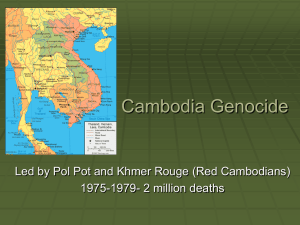
![Cambodian New Year - Rotha Chao [[.efolio.]]](http://s2.studylib.net/store/data/005298862_1-07ad9f61287c09b0b20401422ff2087a-300x300.png)
